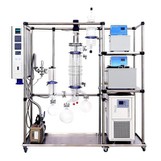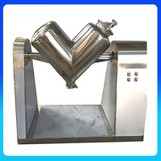Scaling up from a laboratory-scale stirred ball mill to an industrial-scale one is a complex yet crucial process in many industries, including mining, materials science, and chemical engineering. As a stirred ball mill supplier, I've witnessed firsthand the challenges and opportunities that come with this transition. In this blog post, I'll share some insights and practical tips on how to successfully scale up your operations.
Understanding the Basics of Stirred Ball Mills
Before diving into the scaling-up process, it's essential to understand the basic principles of stirred ball mills. These machines use a rotating shaft with stirring arms to agitate grinding media (usually balls) and the material to be ground. The collision and friction between the balls and the material result in particle size reduction.
In a laboratory setting, stirred ball mills are typically used for small-scale experiments and research. They are compact, easy to operate, and allow for precise control of parameters such as speed, temperature, and grinding time. However, when it comes to industrial production, the requirements are significantly different. Industrial-scale stirred ball mills need to handle larger volumes of material, operate continuously for extended periods, and achieve consistent product quality.
Key Considerations for Scaling Up
1. Capacity and Throughput
The first step in scaling up is to determine the required capacity and throughput of the industrial-scale stirred ball mill. This depends on factors such as the production volume, the desired particle size distribution, and the processing time. It's important to note that simply increasing the size of the mill does not always guarantee a proportional increase in capacity. Other factors, such as the design of the stirring mechanism and the flow of the material, also play a crucial role.
To estimate the capacity of an industrial-scale mill, you can start by analyzing the performance of the laboratory-scale mill. Measure the amount of material processed per unit time and the resulting particle size distribution. Then, use this data to scale up based on the desired production volume. Keep in mind that you may need to make some adjustments to account for differences in operating conditions, such as the larger mass of the grinding media and the increased power requirements.
2. Power and Energy Consumption
As the size of the stirred ball mill increases, so does the power and energy consumption. It's important to optimize the design of the mill to minimize energy usage while maintaining efficient grinding performance. This can be achieved through several strategies, such as using high-efficiency motors, optimizing the stirring speed and torque, and reducing friction losses.


When selecting a motor for the industrial-scale mill, consider its power rating, efficiency, and control options. Variable frequency drives (VFDs) can be particularly useful as they allow for precise control of the motor speed, which can help reduce energy consumption during startup and operation. Additionally, ensure that the mill is properly lubricated and maintained to minimize mechanical losses.
3. Material Handling and Feeding
Efficient material handling and feeding are essential for the smooth operation of an industrial-scale stirred ball mill. The system should be able to deliver the material to the mill consistently and at the right rate. This may require the use of conveyors, hoppers, and feeders.
When designing the material handling system, consider the properties of the material, such as its density, particle size, and flowability. For example, if the material is sticky or prone to bridging, special measures may be needed to ensure proper feeding. Additionally, ensure that the system is designed to prevent contamination and minimize the loss of material.
4. Grinding Media Selection
The choice of grinding media is another critical factor in the scaling-up process. The size, shape, and material of the grinding media can significantly affect the grinding efficiency and the resulting particle size distribution. In general, larger grinding media are used for coarse grinding, while smaller media are used for fine grinding.
When scaling up, it's important to select the appropriate grinding media based on the requirements of the industrial process. Consider factors such as the hardness and wear resistance of the media, as well as its compatibility with the material being ground. Additionally, ensure that the grinding media is properly loaded into the mill to achieve optimal performance.
5. Temperature and Pressure Control
Industrial-scale stirred ball mills can generate a significant amount of heat during operation, which can affect the quality of the product and the lifespan of the equipment. It's important to implement effective temperature and pressure control measures to ensure stable operation.
This can be achieved through the use of cooling jackets, heat exchangers, and pressure sensors. The cooling system should be designed to remove the heat generated during grinding and maintain the temperature within the desired range. Additionally, the pressure in the mill should be monitored and controlled to prevent overpressure and ensure safe operation.
Case Studies and Examples
To illustrate the scaling-up process, let's look at a few case studies and examples.
Case Study 1: Mining Industry
In the mining industry, stirred ball mills are commonly used for grinding ores to liberate valuable minerals. A company was using a laboratory-scale stirred ball mill to test the grinding performance of a new ore sample. The laboratory mill had a capacity of 10 liters and was able to process 1 kg of ore per hour.
Based on the results of the laboratory tests, the company decided to scale up to an industrial-scale mill with a capacity of 1000 liters. To achieve this, they increased the size of the mill and optimized the stirring mechanism to ensure efficient mixing of the grinding media and the ore. They also selected a high-power motor and implemented a cooling system to control the temperature during operation.
After the scale-up, the industrial-scale mill was able to process 100 kg of ore per hour, achieving a significant increase in production capacity. The particle size distribution of the ground ore was also consistent with the laboratory results, indicating that the scaling-up process was successful.
Case Study 2: Chemical Industry
In the chemical industry, stirred ball mills are used for grinding and dispersing various chemicals and pigments. A chemical company was using a laboratory-scale mill to develop a new pigment formulation. The laboratory mill had a capacity of 5 liters and was able to produce 0.5 kg of pigment per batch.
To scale up to industrial production, the company designed a larger mill with a capacity of 500 liters. They optimized the feeding system to ensure a continuous supply of raw materials and implemented a quality control system to monitor the particle size distribution and the color of the pigment.
The industrial-scale mill was able to produce 50 kg of pigment per batch, meeting the production requirements of the company. The product quality was also consistent with the laboratory samples, demonstrating the effectiveness of the scaling-up process.
Resources and Equipment for Scaling Up
As a stirred ball mill supplier, we offer a range of products and services to support the scaling-up process. In addition to our industrial-scale stirred ball mills, we also provide related equipment and resources, such as:
- Household Small Freeze Dryer: This equipment can be used for drying and preserving the ground material, ensuring its stability and quality.
- 2L Laboratory Short Path Distillation Kit: Ideal for separating and purifying the components of the ground material, this kit can help improve the product quality.
- Explosion-proof Solvent Recovery Machine: This machine can be used to recover solvents from the grinding process, reducing waste and environmental impact.
Conclusion
Scaling up from a laboratory-scale stirred ball mill to an industrial-scale one is a challenging but achievable task. By carefully considering the key factors discussed in this blog post, such as capacity, power consumption, material handling, grinding media selection, and temperature control, you can ensure a successful transition.
If you're interested in learning more about our stirred ball mills or need assistance with the scaling-up process, please don't hesitate to contact us. Our team of experts is ready to provide you with the support and guidance you need to achieve your production goals.
References
- Smith, J. (2018). Principles of Grinding and Dispersing. New York: Wiley.
- Jones, A. (2019). Industrial Process Scale-Up. London: Elsevier.
- Brown, C. (2020). Advances in Stirred Ball Mill Technology. Journal of Materials Science, 45(2), 321-330.




